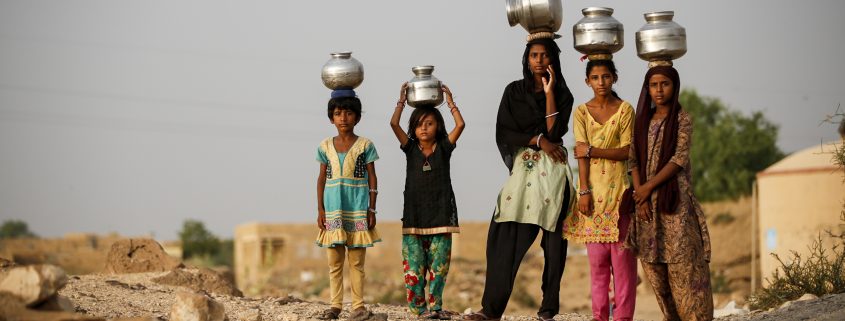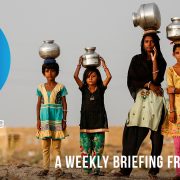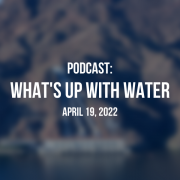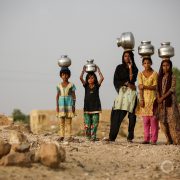What’s Up With Water – Jakarta, Indonesia’s Sinking Capital
What’s Up with Water, your “need-to-know news” of the world’s water.
In India, officials credit early warning systems and swift evacuations for minimizing casualties when Cyclone Fani struck the eastern coast last week. The massive storm hit the state of Odisha, but fewer than 20 fatalities were reported, compared to thousands dead in a similar storm in the region twenty years ago. The state government has been using new weather models to refine evacuation plans, and social media outreach for storm warning and response.
In Mozambique, access to drinking water is a primary concern after Cyclone Kenneth, which hit just five weeks after the devastation of Cyclone Idai. Ongoing heavy rains are causing flash floods and grounding planes, complicating relief efforts on islands and smaller communities surrounding Pemba.
In Iran, rainfall continues to break records. One city received the equivalent of 70 percent of its annual rainfall in a single day earlier this year. After years of drought, unprecedented flooding has disrupted 26 of the country’s 31 provinces in recent months, washing away entire villages in mere minutes. The government has been criticized for its reaction to the crisis, but Iran’s Red Crescent blames U.S. banking sanctions for restricting aid, and climate scientists warn that Iran is not prepared for sharp swings between drought and floods. In the meantime, civilians have stepped up to help those in need.
The El Niño weather pattern is causing water levels in the Panama Canal to tumble as drought grips the region. Draft limits have been imposed on ships, and economic losses are expected to be around $15 million. Bloomberg News says the limits on vessels could harm U.S. agricultural shipments to Asia.
Australia, last week saw the first meaningful rainfall in a year along parts of the parched Darling River. Although it was only 32 millimeters, an inch and a quarter – the rain was welcome at Menindee, where three massive fish-die-offs happened earlier this year. Two independent reports blamed over-extraction of water by irrigators during the drought as part of the cause. The Menindee Lakes system is officially at a mere 1.1 per cent of its capacity, and the river water that is left is plagued by algae, which has been deadly for fish and is causing serious concerns for human health.
Also In Australia, New South Wales bottled water companies are under scrutiny after being accused of illegally extracting groundwater. Last year, a group called the Tweed Water Alliance released data claiming that water trucks were operating in unauthorized areas during a nighttime curfew. In December, the local council submitted a proposed ban on extraction by bottled water companies. An investigation of the claims is ongoing.
The United Nations is holding negotiations on treaties that cover hazardous substances, and over 180 countries are nearing a global ban on PFAS compounds. The debate is over what exemptions will be allowed. PFAS chemicals are widely used in non-stick kitchenware, textiles, food packaging, and fire-suppression foams. A key issue is whether or not to ban this type of firefighting foam, which is a prominent factor in water contamination, and is associated with cancer and other health concerns. China is pushing for continued use of the foam, although other countries have switched to non-PFAS firefighting foam. Major airports including ones in Copenhagen and London are already using alternatives. Negotiations on the PFAS ban are scheduled to end on May 10th.
In South Africa, Dutch engineers are building soccer fields that store and filter water at schools. The innovative fields can process up to 17 million liters of rainwater each year, while children use them for play. The engineers came up with the idea when they visited South Africa for the 2010 World Cup, and imagined a connection between South African’s love of soccer and need for water. The Dutch Ministry of Foreign Affairs is the primary funder of the GreenSource initiative, which has installed nine of its soccer fields across the country.
In Canada, the Ottawa River is receding, after overflowing its banks for the second time in two years. Heavy rainfall and rising rivers forced several thousand people in eastern Canada to evacuate, and military personnel helped residents protect their homes in Quebec, Ontario, and New Brunswick. The Canadian Broadcasting Corporation reports that Ministers for emergency management are talking about the rising costs of disaster response and how to strengthen communities to withstand severe weather. Quebec’s premier has also proposed financial incentives for homeowners to move away from flood-prone areas.
In the United States, Washington D.C. announced plans to upgrade or remove all flood-prone homes, businesses, and hospitals in anticipation of worsening climate change. Washington is the first U.S. city to introduce this type of policy, and says it hopes to have the project completed by 2050.
A new study finds that extreme rainfall has been just as harmful to U.S. crops as drought and heat. University of Illinois researchers looked at U.S. corn yields from 1981 to 2016. In some years, the crop loss caused by torrential rains was up to 34 percent of the expected yield. In dry years, up to 37 percent of expected yield was lost. Many climate models predict that the Corn Belt states will see more intense rain in the spring, and researchers are urging better risk management strategies.
In California, a new report warns that contaminants in the state’s drinking water could be the cause of over 15,000 new cases of cancer. The Environmental Working Group study analyzed nearly 3,000 state water systems. It claims that the combined health impacts of contaminants such as arsenic and hexavalent chromium are likely to cause thousands of cancer cases.
A study by NASA’s Goddard Institute for Space Studies claims that human activities have worsened drought risk since the early 20th century. Researchers analyzed tree-ring data, soil moisture measurements, and drought records. They found that this actual data matches scientific predictions about the impact of human-generated greenhouse gas
emissions on the global climate.
Circle of Blue reports on Indonesia, where a sinking city has given rise to speculation about the country’s capital.
The front-runner in Indonesia’s presidential election indicated that he supports moving the center of government out of Jakarta to higher, less congested ground. President Joko Widodo, who is leading the vote count in his reelection campaign, reportedly discussed three relocation ideas in a closed cabinet meeting, according to the BBC . The options represent increasing levels of logistical and financial complexity. The simplest option would move government offices within the city. A second option would relocate them outside of Jakarta but within the metropolitan area.
Widodo’s preferred option, according to reports, is the most ambitious: to build a new capital city away from Java, the country’s most populous island and the center of political power.
There are a number of reasons to justify the move. Traffic in Jakarta, home to more than 10 million people, is unbearable. Relocating the capital can be politically pragmatic when looking to undo the geographical concentration of power. Brazil and Kazakhstan are two countries that moved their capitals inland in the 20th century.
One factor that cannot be ignored is that parts of Jakarta are rapidly sinking, as much as 4 meters (13 feet) since the 1970s. This land subsidence is driven by excessive groundwater pumping that causes soils to compact. Movement of the land can topple buildings, and it has forced residents to abandon homes that tilt dangerously. Subsidence is one reason that [WE-doe-doe] Widodo floated the relocation idea.
Unchecked groundwater use is creating a monumental flooding hazard for the city’s low-lying areas, especially along the harbor, where sinking land draws the waters of Jakarta Bay ever closer. City officials are already at work on a massive sea wall across the bay.
The only way to stop the subsidence is to stop pumping groundwater, particularly from deep zones that get little recharge. That recommendation was made years ago in a conference organized by the province of Jakarta, the public works ministry, and Deltares, a Dutch organization that is one of the leaders in subsidence research.
And that’s What’s Up With Water…we’d like to know what’s up where you are – Tweet us with your water news @circleofblue #whatsupwithwater.
Eileen Wray-McCann is a writer, director and narrator who co-founded Circle of Blue. During her 13 years at Interlochen Public Radio, a National Public Radio affiliate in Northern Michigan, Eileen produced and hosted regional and national programming. She’s won Telly Awards for her scriptwriting and documentary work, and her work with Circle of Blue follows many years of independent multimedia journalistic projects and a life-long love of the Great Lakes. She holds a BA and MA radio and television from the University of Detroit. Eileen is currently moonlighting as an audio archivist and enjoys traveling through time via sound.












Leave a Reply
Want to join the discussion?Feel free to contribute!